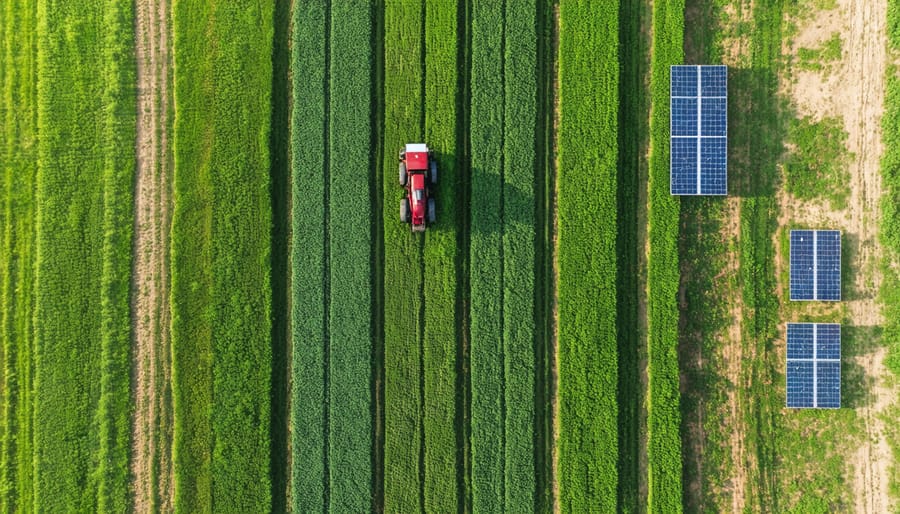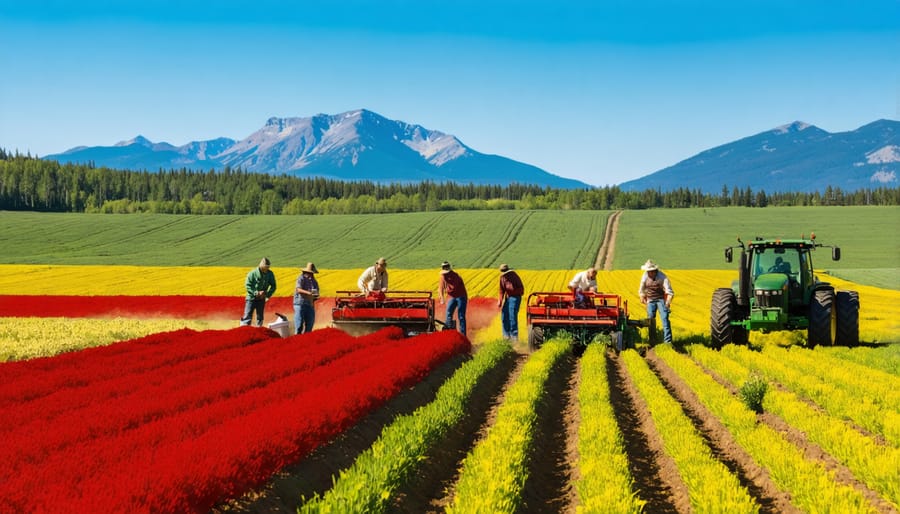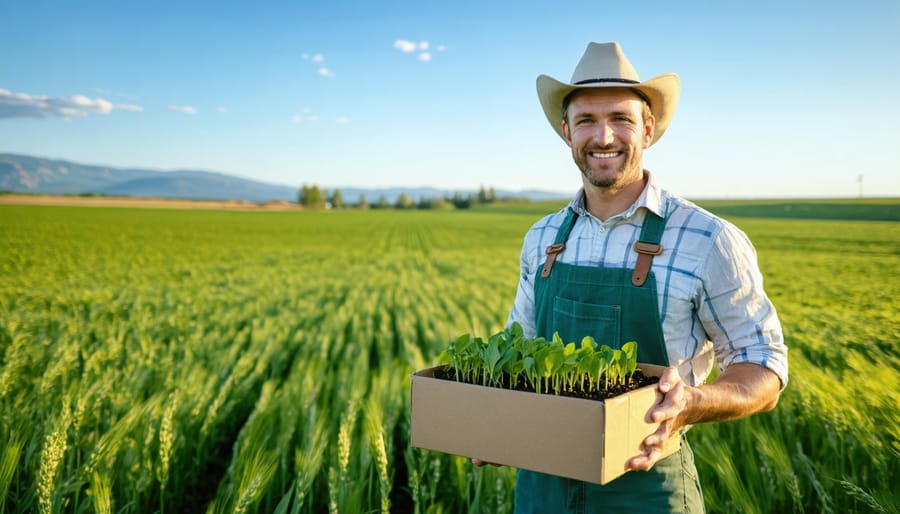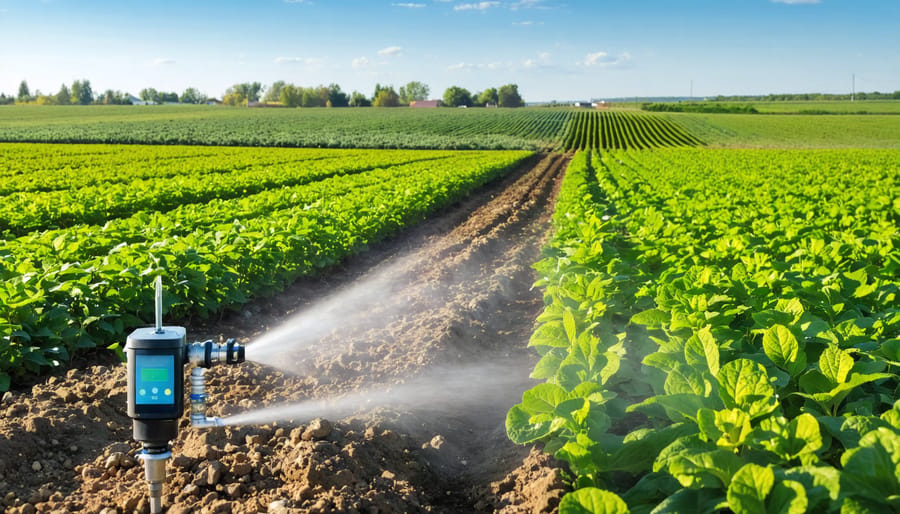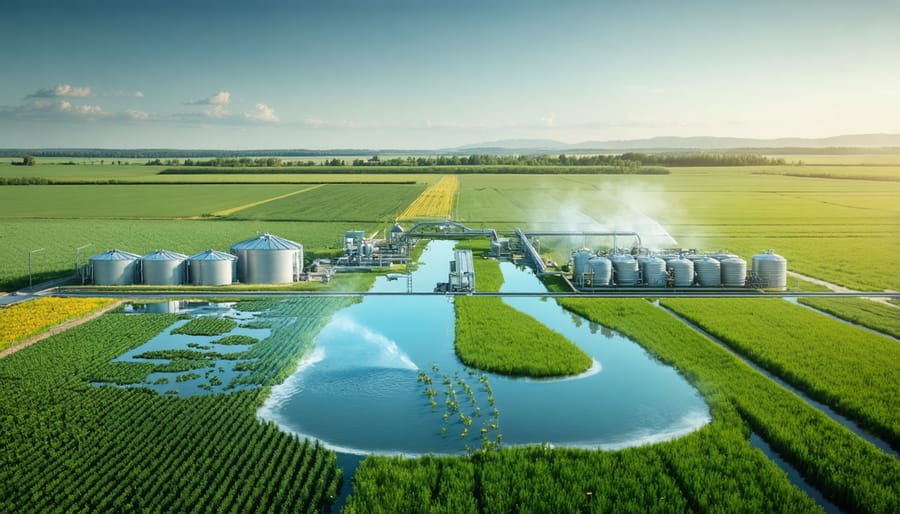Canadian farmers are leading a revolution in carbon-smart agriculture, turning their fields into powerful carbon sinks while maintaining robust crop yields. Across Alberta’s prairies, innovative farming practices are reducing agricultural emissions by up to 25% while improving soil health and farm profitability. By implementing precision agriculture techniques, adopting no-till practices, and strategically managing crop rotations, producers are demonstrating that environmental stewardship and economic success can work hand in hand.
The agriculture sector accounts for 10% of Canada’s greenhouse gas emissions, but it also holds unique potential as a carbon storage solution. Through regenerative practices, our farmlands can sequester millions of tonnes of carbon annually while producing more nutritious food and creating more resilient farming operations. Local success stories, from Medicine Hat to Grande Prairie, show that reducing carbon footprints often leads to reduced input costs and improved crop resilience.
This transformation isn’t just about environmental responsibility—it’s about securing the future of Canadian agriculture. With carbon credit programs and sustainable agriculture incentives becoming increasingly available, farmers who adapt now are positioning themselves at the forefront of a more sustainable and profitable agricultural future.
Understanding Your Farm’s Carbon Footprint
Key Sources of Agricultural Carbon Emissions
In Canadian agriculture, carbon emissions primarily stem from four key areas. Livestock operations, particularly cattle farming, contribute through enteric fermentation – the natural digestive process that produces methane. Here in Alberta, where we have one of the largest cattle populations in Canada, this represents a significant portion of our agricultural emissions.
Soil management practices, including tillage and fertilizer application, form the second major source. When we disturb soil or apply nitrogen-based fertilizers, we release stored carbon and nitrous oxide into the atmosphere. Many Alberta farmers are already seeing how reduced tillage can help address this.
Farm equipment and machinery represent another substantial source, with diesel-powered tractors and combines releasing CO2 during field operations. Additionally, energy use in farm buildings, particularly for heating and cooling livestock facilities, contributes to our carbon footprint.
Manure management rounds out the main emission sources, releasing both methane and nitrous oxide. However, many local farmers are turning this challenge into an opportunity through innovative composting and biogas systems that capture these emissions while creating valuable by-products.
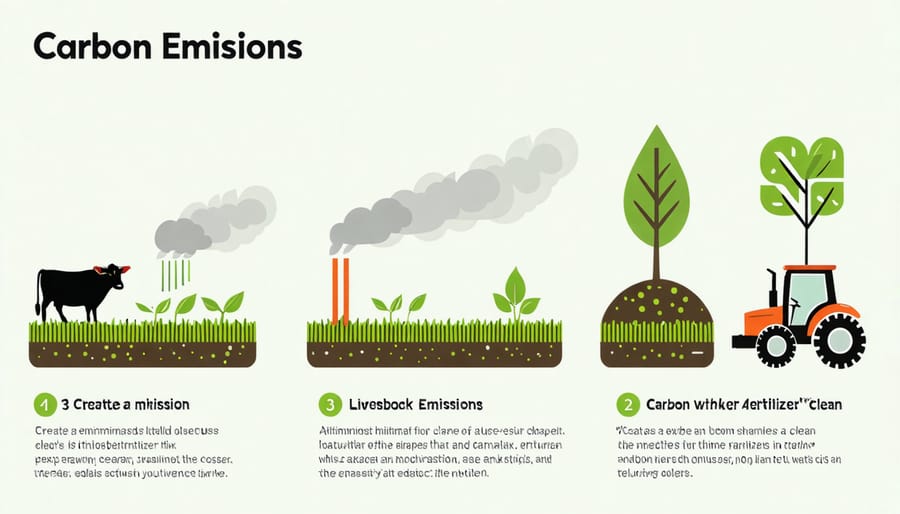
Measuring Your Farm’s Carbon Impact
Measuring your farm’s carbon footprint doesn’t have to be complicated. Several user-friendly tools are available specifically for Canadian farmers. The Alberta Farm Sustainability Extension (AFSE) calculator is particularly helpful, allowing you to input your farm’s specific data and receive a detailed emissions report.
Start by gathering key information about your operation: fuel consumption, electricity usage, fertilizer application rates, and livestock numbers. Modern digital record-keeping systems make this process straightforward, and many local agricultural offices provide assistance with data collection.
For a comprehensive assessment, consider working with a qualified agricultural carbon advisor. These professionals can help you identify both direct emissions (from equipment and livestock) and indirect emissions (from purchased inputs and transportation). Many Alberta agricultural societies offer subsidized consultation services for first-time assessments.
Remember to track your measurements seasonally, as carbon emissions can vary significantly throughout the year. Keep detailed records of any changes you implement – this data will be valuable for carbon credit programs and demonstrating your farm’s environmental progress to stakeholders.
Supply Chain Carbon Reduction Strategies
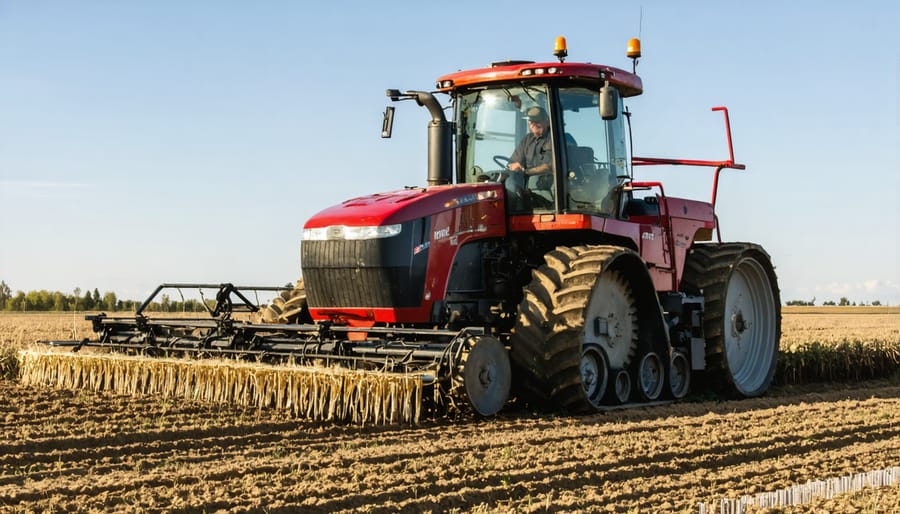
On-Farm Production Improvements
Modern farming practices offer numerous opportunities to reduce carbon emissions while maintaining or improving productivity. Implementing no-till farming techniques can significantly decrease soil disturbance, helping to lock carbon in the ground while reducing fuel consumption from machinery. Many Alberta farmers have successfully adopted this practice, reporting up to 30% reduction in diesel usage.
Crop rotation and cover cropping are equally vital strategies, particularly suited to our Prairie climate. These practices enhance soil organic matter and reduce the need for synthetic fertilizers, which are major contributors to agricultural emissions. Local success stories show that incorporating legumes into rotation can cut nitrogen applications by up to 25%.
Precision agriculture technology, including GPS-guided equipment and variable-rate application systems, helps optimize resource use. These tools ensure inputs are applied only where needed, reducing waste and associated emissions. Combined with renewable energy solutions, such as solar-powered irrigation systems and biogas digesters, these innovations are transforming Canadian farm operations.
Proper grazing management in livestock operations also plays a crucial role. Rotational grazing helps maintain healthy grasslands that act as carbon sinks while improving animal productivity. Many Alberta ranchers have documented increased soil carbon levels of 2-3% over five years through strategic grazing practices.
Transportation and Storage Solutions
Efficient transportation and storage practices play a crucial role in reducing your farm’s carbon footprint. Here in Alberta, where distances between farms and markets can be significant, smart logistics planning can make a substantial difference.
Local grain farmer Sarah Thompson from Red Deer reduced her operation’s emissions by 15% by implementing a route optimization system for her delivery trucks. “We now combine deliveries and choose the most fuel-efficient routes,” she explains. “The savings in both fuel costs and emissions have been significant.”
Consider these practical solutions for your operation:
– Use energy-efficient storage facilities with proper insulation and temperature control
– Implement batch deliveries to reduce the number of trips
– Maintain vehicles regularly for optimal fuel efficiency
– Choose storage locations strategically to minimize transport distances
– Invest in renewable energy solutions for cold storage facilities
The Prairie Agricultural Machinery Institute recently demonstrated that proper grain storage management can reduce spoilage-related emissions by up to 20%. This includes using aeration systems effectively and monitoring grain condition regularly.
For livestock operations, consider partnering with neighbouring farms for shared transportation. The County of Grande Prairie’s cooperative transport initiative has helped local ranchers reduce their transport-related emissions by 25% while cutting costs.
Remember to track your transportation and storage emissions using available carbon calculators – this data can help identify areas for improvement and may qualify you for provincial carbon credit programs.
Processing and Packaging Innovations
Canadian farmers are increasingly adopting innovative processing and packaging methods to reduce their carbon footprint while maintaining product quality. Modern processing facilities are implementing energy-efficient equipment and waste reduction systems that significantly decrease emissions during post-harvest handling.
Many Alberta producers have successfully integrated sustainable packaging solutions into their operations, such as biodegradable materials and minimalist designs that reduce packaging weight. For example, the Red Deer Valley Cooperative has decreased their packaging-related emissions by 40% by switching to locally-sourced recyclable materials and optimizing their package sizes.
Cold storage innovations have also made significant strides, with new facilities using natural refrigerants and smart monitoring systems that minimize energy consumption. Several farms in central Alberta have implemented solar-powered cold storage units, cutting their processing-related emissions by up to 60%.
Batch processing optimization and improved logistics planning have helped reduce waste and transportation emissions. The introduction of mobile processing units has allowed smaller farms to access efficient processing technology while minimizing transportation needs. These units, now available through several equipment-sharing programs across Alberta, have helped reduce processing-related carbon emissions by an average of 30% for participating farms.
Success Stories from Alberta’s Fields
The Thompson Family Farm Transformation
Located just outside of Olds, Alberta, the Thompson Family Farm has become a shining example of how traditional farming operations can successfully transition to low-carbon practices. In 2018, John and Sarah Thompson made the bold decision to overhaul their 800-hectare grain and cattle operation after calculating their farm’s carbon footprint.
The Thompsons implemented a comprehensive three-year plan that included adopting no-till farming practices, introducing cover crops, and integrating AI-driven farming innovations for precision agriculture. They installed solar panels to power their grain drying system and converted their fleet to include two electric tractors.
The results have been remarkable. By 2022, the farm reduced its carbon emissions by 45% while maintaining productivity. Their soil organic matter increased from 2.8% to 4.2%, significantly improving water retention and reducing fertilizer needs. The Thompsons also report annual energy cost savings of approximately $32,000.
“The transition wasn’t always smooth,” Sarah admits, “but the support from our local agricultural extension office and fellow farmers made it possible.” The farm now serves as a demonstration site for the Alberta Carbon Smart Agriculture Program, hosting regular field days where other farmers can learn from their experience.
The Thompsons’ success story shows that with careful planning and the right support, reducing carbon emissions can align with both environmental stewardship and financial success.
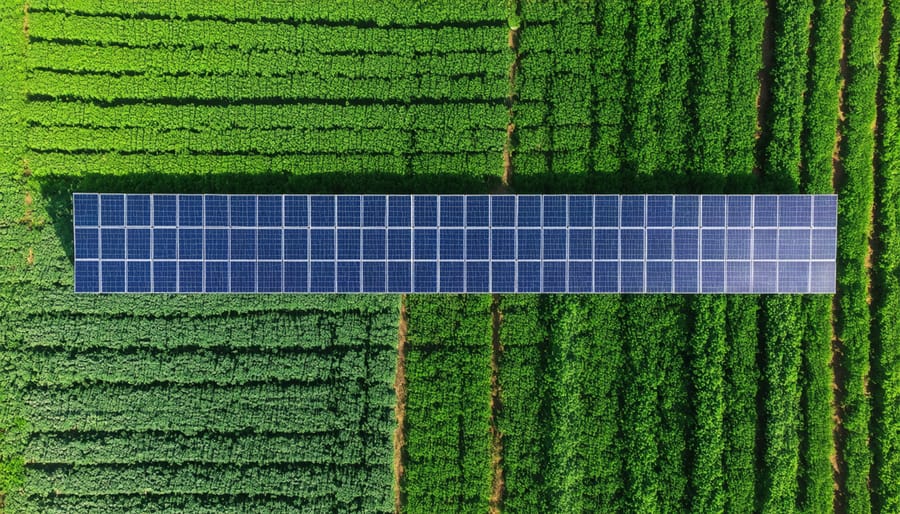
Collective Action: The Red Deer Valley Initiative
In 2019, farmers along Alberta’s Red Deer Valley launched a groundbreaking initiative to collectively reduce their agricultural carbon footprint. This community-driven project now involves over 50 local farms working together to implement sustainable practices while maintaining profitable operations.
The initiative centers on a peer-support network where farmers share experiences, resources, and successful strategies. Monthly meetings rotate between participating farms, allowing members to observe different implementation approaches firsthand. Notable achievements include a 25% reduction in collective fertilizer use through precision agriculture techniques and the establishment of a shared composting facility serving multiple properties.
“What makes this work is that we’re all in it together,” explains Sarah Thompson, a third-generation farmer and project coordinator. “When one farm succeeds with a new method, everyone benefits from that knowledge.” The group has created a mentorship program pairing experienced sustainable farmers with those just beginning their carbon reduction journey.
The initiative has attracted attention from agricultural organizations across Canada, with similar programs now emerging in Saskatchewan and Manitoba. Financial benefits have been significant, with participating farms reporting average annual savings of $15,000 through reduced input costs and improved soil management practices.
The Red Deer Valley group also maintains strong partnerships with local agricultural extension services and research institutions, ensuring their practices are backed by current scientific data while remaining practical for real-world application.
Economic Benefits and Support Programs
Government Incentives and Programs
Canadian farmers have access to several government-backed initiatives designed to support sustainable agricultural practices. The Agricultural Clean Technology Program offers funding of up to $2 million for projects that reduce emissions while improving farm efficiency. Alberta’s TIER system provides carbon credits for verified emissions reductions, allowing farmers to generate additional revenue through carbon offset markets.
The Canadian Agricultural Partnership (CAP) offers cost-sharing programs specifically for environmental improvements, including grants for energy-efficient equipment upgrades and sustainable land management practices. Farmers can receive up to 50% coverage for eligible projects through the Environmental Stewardship and Climate Change Producer Program.
The On-Farm Climate Action Fund supports three key areas: nitrogen management, cover cropping, and rotational grazing practices. Alberta producers can also benefit from the Environmental Farm Plan program, which provides guidance and potential funding for implementing sustainable practices.
Local agricultural fieldmen and regional specialists are available to help farmers navigate these programs and complete applications. The Agriculture Financial Services Corporation (AFSC) offers additional lending options specifically designed for environmental improvements on farms.
Cost Savings and Market Advantages
Reducing your farm’s carbon footprint isn’t just good for the environment – it can significantly boost your bottom line. Many Alberta farmers report substantial cost savings through carbon-smart practices, particularly in fuel and fertilizer expenses. For instance, implementing no-till farming can save up to $45 per hectare annually in fuel costs, while precision agriculture technologies typically reduce fertilizer use by 15-20%.
Carbon offset programs in Alberta offer additional revenue streams, with farmers earning between $15 and $30 per tonne of carbon sequestered. Early adopters of sustainable practices also gain a competitive edge in the marketplace, as major food companies increasingly prioritize low-carbon suppliers. Several Canadian grain companies now offer premium prices for crops grown using verified sustainable methods.
Energy-efficient equipment upgrades often qualify for government grants and tax incentives, further reducing implementation costs. The Canadian Agricultural Partnership program provides funding of up to 50% for qualifying environmental improvements. Additionally, farms using sustainable practices typically see improved soil health and water retention, leading to better crop resilience and reduced input costs over time.
As we’ve explored throughout this article, reducing agriculture’s carbon footprint isn’t just an environmental imperative – it’s a practical path toward more efficient and profitable farming in Alberta and across Canada. The strategies we’ve discussed, from precision agriculture to improved soil management practices, offer tangible benefits for both the environment and your bottom line.
Remember that every farm’s journey toward carbon reduction is unique. Start with the methods that make the most sense for your operation, whether that’s implementing no-till practices, optimizing fertilizer use, or exploring renewable energy options. The key is to begin somewhere and build upon your successes.
Take advantage of the support systems available to you. Connect with local agricultural extension services, join farmer-led initiatives, and explore government incentives designed to help with the transition to lower-carbon practices. Your fellow Alberta farmers are valuable resources – many have already pioneered successful carbon reduction strategies and are willing to share their experiences.
By taking steps to reduce your farm’s carbon footprint, you’re not only contributing to Canada’s climate goals but also positioning your operation for long-term success. The future of farming is sustainable, profitable, and community-minded. Together, we can build an agricultural sector that leads the way in environmental stewardship while maintaining our position as world-class food producers.
Start your carbon reduction journey today – your land, your business, and future generations will thank you for it.

